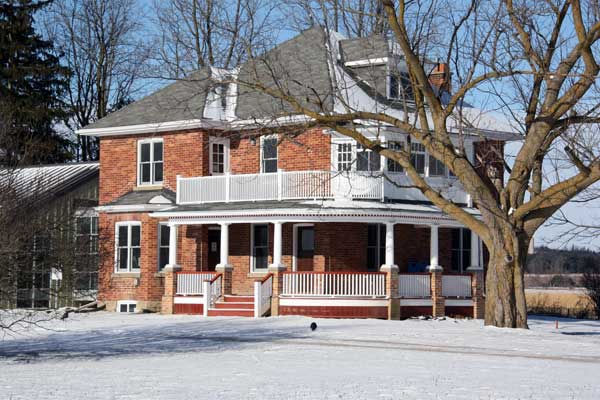
Understanding insulin: high school students explore the legacy of Sir Frederick Banting
Published: December 20, 2013
“How many of you have a family member with diabetes?”
David Sadleir puts the question to students from a grade 10 science class, who have just walked half an hour from Banting Memorial High School in Alliston to tour the birthplace of the University of Toronto's Sir Frederick Banting, co-discoverer of insulin.
About a third of the students raise their hands. Sadleir nods. Across Canada, 9 million people have diabetes or prediabetes, Sadleir tells the group. Around the world, 438 million will have diabetes by 2030.
“Those numbers are big,” he says, “but what’s really scary is that more and more, they are made up of young people like you.”
Doctors in Canada are seeing kids with type 2 diabetes as early as age eight. In the United States, the number of children with type 2 diabetes is at least 10 times higher than it was just over a decade ago. Childhood rates for this form of the disease – which used to be called “adult-onset” diabetes – are growing around the world.
The good news is that the link between lifestyle and prevention and management of diabetes is stronger than ever. A healthy diet and regular exercise can dramatically lower the risk of getting the disease, and improve outcomes for those who have it.
To get that message out, and to honour the discovery of insulin at the University of Toronto in 1921, the Sir Frederick Banting Legacy Foundation has restored the property on which Banting was born, and turned it into a cultural and educational hub.
The foundation recently received $249,500 from the Ontario Trillium Foundation to help run the facility for the next three years. The students from Banting Memorial are the first in the foundation’s school tours program, which Sadleir hopes will bring 700 kids to the property from across Ontario each year.
 “Insulin has saved maybe a billion lives. For a discovery with impact, it’s hard to beat that one,” says Sadleir (pictured right). The former professor of mechanical and industrial engineering and vice-president at U of T has been the foundation’s president since 2010.
“Insulin has saved maybe a billion lives. For a discovery with impact, it’s hard to beat that one,” says Sadleir (pictured right). The former professor of mechanical and industrial engineering and vice-president at U of T has been the foundation’s president since 2010.
“As the birthplace of Banting, we knew this property offered a tremendous opportunity to preserve his legacy and fight diabetes through education and research.”
Megan McLaughlin is one of the two dozen high school students visiting the site. Their tour includes a tutorial by Sadleir on the 50-year trail of scientific inquiry that led to the discovery of insulin and its mass production, and a “scavenger hunt” among the exhibits for answers to questions about diabetes.
“I didn’t realize the discovery came at the end of such long process,” says McLaughlin, who has several family members living with diabetes. “I learned a lot today.”
The exhibits include a rotating selection from among hundreds of artifacts, manuscripts and paintings, drawn from the Banting Digital Library, the Thomas Fisher Rare Books Library at U of T, the Museum on the Boyne and other sources. Outreach partners from Stevenson Memorial Hospital and Southlake Regional Health Centre recently delivered the foundation’s first class for diabetes patients, and Sadleir says public access to the site should start in 2014.
Sheila Dickson is McLaughlin’s teacher and the chair of the science department at Banting Memorial. She says the facility is great for the community, and offers her school a chance to build on its curriculum with fascinating science and local history while emphasizing topics like nutrition that are important to today’s students.
“And I love Banting’s story,” says Dickson. “He came from rural Ontario, like many of our students. Good things can come from small schools.”
Jim Oldfield is a writer with the Faculty of Medicine at the University of Toronto.



